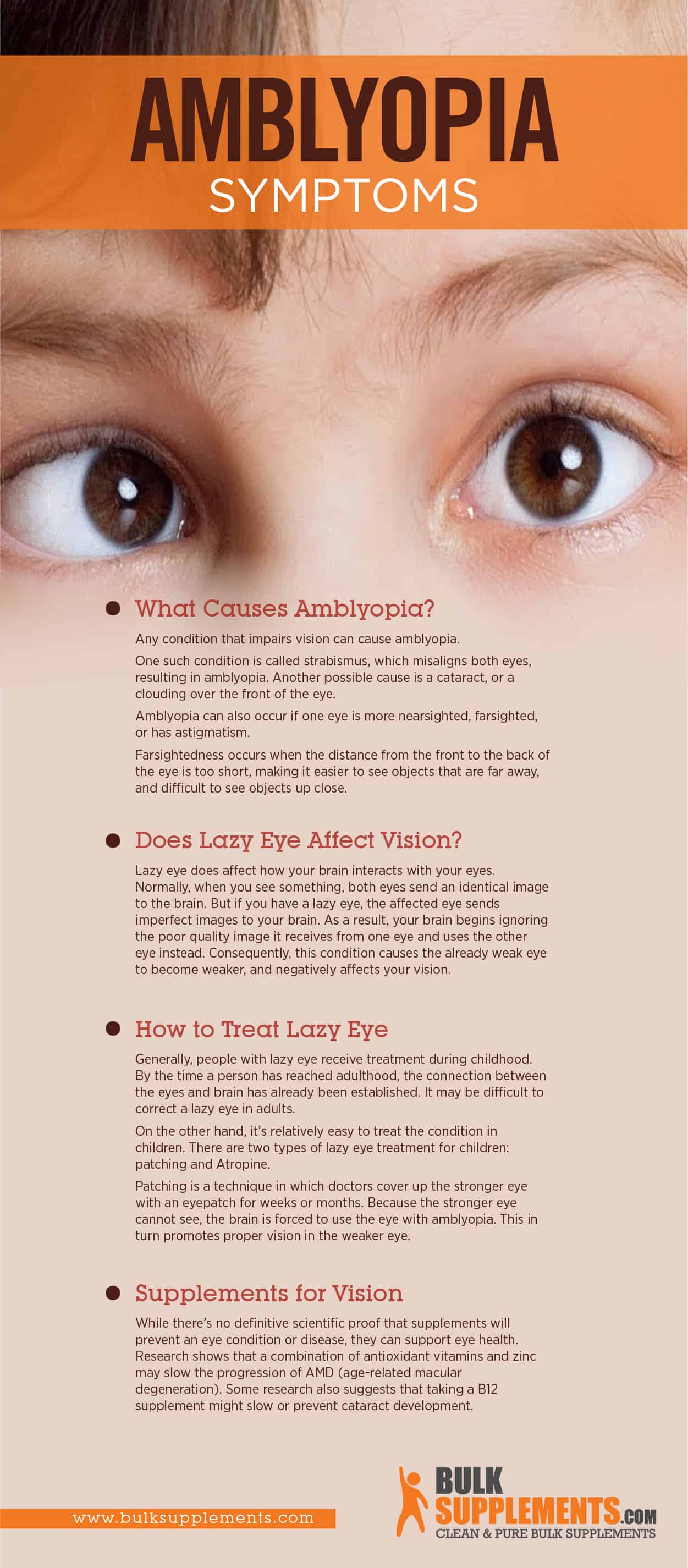Amblyopia (Lazy Eye) Symptoms, Diagnosis, and Treatment

Ambylopia
What is Amblyopia?
Amblyopia, or lazy eye, refers to a condition in which the brain and the eyes are not working together. This condition reduces the vision in one eye, making the brain use that eye less often. As a result, the brain begins favoring the other eye (x). This makes the eye that the brain doesn’t use weaker, giving it a “lazy” appearance.
What Causes Amblyopia?
Any condition that impairs vision can cause amblyopia.
One such condition is called strabismus, which misaligns both eyes, resulting in amblyopia. Another possible cause is a cataract, or a clouding over the front of the eye.
Amblyopia can also occur if one eye is more nearsighted, farsighted, or has astigmatism.
Farsightedness occurs when the distance from the front to the back of the eye is too short, making it easier to see objects that are far away, and difficult to see objects up close.
In contrast, nearsightedness occurs when the distance from the front of the eye to the back is too long. This means it’s easier to see objects that are closer to you, and difficult to see objects at a distance.
Astigmatism causes the eye to be football-shaped, making it difficult to focus on objects that are both near and far away.
Does Lazy Eye Affect Vision?
Lazy eye does affect how your brain interacts with your eyes. Normally, when you see something, both eyes send an identical image to the brain. But if you have a lazy eye, the affected eye sends imperfect images to your brain. As a result, your brain begins ignoring the poor quality image it receives from one eye and uses the other eye instead. Consequently, this condition causes the already weak eye to become weaker, and negatively affects your vision.

How to Treat Lazy Eye
Generally, people with lazy eye receive treatment during childhood. By the time a person has reached adulthood, the connection between the eyes and brain has already been established. It may be difficult to correct a lazy eye in adults.
On the other hand, it’s relatively easy to treat the condition in children. There are two types of lazy eye treatment for children: patching and Atropine.
Patching is a technique in which doctors cover up the stronger eye with an eyepatch for weeks or months. Because the stronger eye cannot see, the brain is forced to use the eye with amblyopia. This in turn promotes proper vision in the weaker eye.
Available as an eye drop, atropine is a medication that blurs the vision in the stronger eye. Because it weakens the stronger eye, it forces the weaker eye to do most of the work, improving vision. When administered once a day, Atropine has been proven to be just as effective as patching.
SEE ALSO

Lymphedema: Symptoms, Causes & Treatments
Supplements for Vision
While there’s no definitive scientific proof that supplements will prevent an eye condition or disease, they can support eye health. Research shows that a combination of antioxidant vitamins and zinc may slow the progression of AMD (age-related macular degeneration). Some research also suggests that taking a B12 supplement might slow or prevent cataract development.
Always talk to your doctor before taking any supplements for vision or an eye condition–and make sure the supplements don’t interact with medications you may be taking.
The Bottom Line
Also known as lazy eye, amblyopia is a condition in which vision is weaker in one eye. A common condition in children, doctors can treat it using an eye patch or medication that forces the weak eye to strengthen over the course of several months.
While supplements can’t prevent eye disease, they can help support healthy vision and slow the progression of AMD. If you think you or your child might have amblyopia, make an appointment with your doctor. They can help determine the best course of treatment for you.



